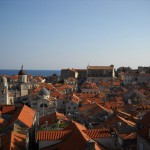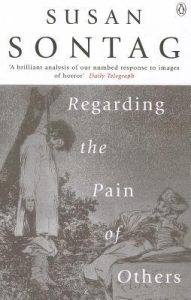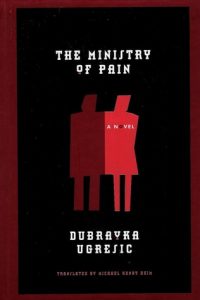
Of the Bosnian War, I remember only images on CNN of the bombing of Sarajevo. My excuse is that I was a teenager, though I lived for a year in Eastern Europe during the height of the war and should have been more aware. I later studied it in Political Science, but I could never find an entry point to start to relate to it on a human rather than academic scale. Even Dubravka Ugrešić’s The Ministry of Pain felt abstract despite her incredible depiction of the war’ effects on one person. Reading more relatable books by Ismet Prcic and Saša Stanišić in preparation for our trip humanized the war, but the former Yugoslavia still seemed like a far off place. As Susan Sontag writes in Regarding the Pain of Others, “The memory of war…is mostly local.”
Flying from Paris to Zagreb, I wondered at the large, orderly collections of dark rectangles on the ground. They were too small to be cars. As the plane descended, I realized they were all near churches and that they must be graves. They looked so fresh and plentiful. I started to feel leaden.
 I tried to forget about the graves as we flew to Dubrovnik and entered the beautiful, walled old Town. For a couple of days I was a right good tourist exploring the sights and spending money. But I kept looking for signs of the war. The guidebook said the only evidence we would see of the bombing of Dubrovnik was the new red tile roofs. It wasn’t until walked the walls that I saw that most of the roofs were the bright red of new tile. Almost no building was left untouched. I wanted to think that there were other reasons for some of the new roofs, but there were so many of them…I was curious and I wanted to know more, but I didn’t know who to ask and I didn’t want to be rude. I wanted to see the place for more than its war experiences, but I couldn’t stop thinking about it.
I tried to forget about the graves as we flew to Dubrovnik and entered the beautiful, walled old Town. For a couple of days I was a right good tourist exploring the sights and spending money. But I kept looking for signs of the war. The guidebook said the only evidence we would see of the bombing of Dubrovnik was the new red tile roofs. It wasn’t until walked the walls that I saw that most of the roofs were the bright red of new tile. Almost no building was left untouched. I wanted to think that there were other reasons for some of the new roofs, but there were so many of them…I was curious and I wanted to know more, but I didn’t know who to ask and I didn’t want to be rude. I wanted to see the place for more than its war experiences, but I couldn’t stop thinking about it.
On our final day in Dubrovnik, we turned from sunny Stradun street with its masses of tourists down a narrow side street and stepped into War Photo Limited. There were three main exhibits that day: Blood & Honey by Ron Haviv, Srebrenica Genocide 11/07/95 by Tarik Samarah, and Bosnians by Paul Lowe. Wandering though those exhibits, I saw images of the aftermath of the Bosnian War: mass graves, survivors being DNA tested to identify corpses, and bones that no one bothered to bury. Sontag had seen these photos. She wrote broadly about images from the Bosnian War and specifically about Ron Haviv’s image of a Serb kicking a Muslim woman’s corpse.
There are images that recur in conflict and thus war photography—starving people and mass graves are all too common. Sontag writes “shock can become familiar” and this exhibit contained some images familiar from conflicts past, including images of dolls as a metaphor for the loss of innocence. I had seen images like these from World War II and Viet Nam but they didn’t speak to the unique character of the conflict and I wished I could have learned more from them. In contrast, one of the more affecting images was of a decomposing corpse and the Koran that had fallen from his hand. The image spoke specifically to this one conflict and to the young man who was torn from his home and who was likely praying when he was murdered. I thought of the families detailed in Prcic and Stanišić’s books who had been forced out of their homes and then murdered. One of my favorite photographs showed people congregating for water outside bombed out buildings. I thought of Prcic’s hero and the lengths he went to in order to shower to impress a girl and how Prcic found a way to marry the perfect detail in a story with something that spoke to the larger condition.
When I saw an image of an American law enforcement agent searching a field for graves, I found my connection to this story. Madeleine Albright wrote in her autobiography about her disappointment with the way the US handled the Bosnian War—with how long it took us to get involved. I don’t advocate for widespread US intervention, but I do think the world community has a moral imperative to intervene when civilians are being killed. When genocide is being committed. After all the time I spent reading about the Holocaust as a child, I thought it couldn’t happen again, that we knew better. Part of what I was experiencing in Croatia was disbelief that it did. In Bosnia, Rwanda, Syria, and so many more places.
Sontag writes, “One should feel obliged to think about what it means to look at” war photography and I have been thinking about my motives. The exhibit did not quell my curiosity. I still examined buildings for bullet holes and wondered about the story and family behind each burned out house. In fact the exhibit made me more curious, but it also framed that curiosity. Instead of worrying about the base nature of humans, I am focusing on the history. I am learning where places like Vukovar, Tuzla and Srebrenica are on the map. I am thinking about the wonderful, friendly people we met throughout Croatia and Slovenia and about how they are like people everywhere. It’s far too easy to watch war on the TV or even to change the channel. Somewhere inside I have always been terrified that war could happen to me and I think that is the real reason I have disengaged. But the Bosnian War is no longer a war that happened somewhere to someone else. War can happen anywhere to anyone. I hope never to experience it, but I’m no longer going to pretend it couldn’t happen to me. I’m not going to let my fear be an excuse for ignoring what is happening in the world.
If this review made you want to read the book, pick up a copy of Regarding the Pain of Others from Bookshop.org. Your purchase keeps indie booksellers in business and I receive a commission.
 We’re coming back from Croatia today, so here, at long last, is a post on Ugrešić.
We’re coming back from Croatia today, so here, at long last, is a post on Ugrešić.